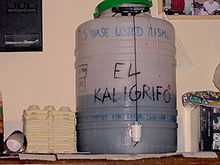Kalimotxo
 | |
| A porrón with kalimotxo and the used bottle of 1983 vintage wine. | |
| Primary alcohol by volume | |
|---|---|
| Served | On the rocks; poured over ice |
| Standard drinkware | |
| Commonly used ingredients | |
| Preparation | Stir together over plenty of ice. |
Kalimotxo, also known as cocavino, is a drink consisting of equal parts red wine and cola-based soft drink.[1][2] Although recently developed, it has become an icon of Basque culture.[3]
Preparation and serving

Kalimotxo is served in bars in short glass tumblers. Plenty of ice is added, then the red wine and cola. In other areas the drink is served in tall glasses. Sometimes Ouzo or anise flavoring is added. Another variation calls for a lime twist.
A common way of serving kalimotxo is in one liter drinking glasses made of plastic, called minis, cachi, macetas, litros, cubalitros or jarras. The mixture is made directly in this one-liter mini, and often the bottles of cola are reused to make more of the mixture. This is done by emptying half of a two-liter cola bottle and adding one litre of red wine to the bottle. Ice is usually added to the drink. The minis are then shared among the group of drinkers, especially during the botellón drinking street gatherings.
In times of fewer available resources, a common occurrence among Spanish youth, (lack of one liter 'mini') drastic measures are taken by young Spaniards in order to save money. One common cheap way of mixing Calimocho involves a plastic bag and the Tetra Brik cartons of cheap red wine (Don Simón is a common brand). An entire two liter bottle of Coca-Cola and two liters of wine are emptied into a plastic shopping bag. Once the concoction is mixed in the bag, the bag is squeezed tightly around the rim of the two litre Coca-Cola bottle and the contents of the bag are poured into the bottle. The now-empty Tetra Brik wine cartons are fully opened and peeled back as to mimic the function of the 'mini'. The Coca-Cola bottle is then used as a distribution device to fill the makeshift 'mini'.
One variation of the drink is achieved by adding a dash of blackberry liqueur. Similar concoctions using red wine include pitilingorri or caliguay (50% white wine and 50% lemon-flavored soft drink), (see spritzer); pitilin gorri (50% red wine and 50% orange soda). "Tinto de verano", more common outside of the Basque country, is half red wine and half "Casera", a mildly sweet sparkling water. In another variation, one may add to the 50/50 cola and red wine drink a dash of the Greek apertif Ouzo to create a drink called a Pallas.
Name
It is not clear where the name comes from. In the early 1970s it was called Rioja Libre or Cuba Libre del pobre (poor man's Cuba Libre) in some Spanish provinces.
The current name, "Kalimotxo", is attributed to the "Antzarrak cuadrilla" ("Geese young friends circle"), which supposedly coined it during the 1972 Puerto Viejo festivities (in Algorta, Getxo, Basque Country). Legend has it that the servers in one of the "txozna" (stands in Basque festivals where drinks are served) noticed that the wine they had bought was not in good condition, so they decided to mix it with something to kill the sour taste. The inventors of the mixture named it after two friends of the cuadrilla known as "Kalimero" (after the Calimero chicken character) and "Motxo", hence the name "Kalimotxo". The name caught on and became popular throughout Spain.[4]
The spelling kalimotxo has been in use in the Southern Basque Country since the 1970s. The Sandevid corporation, which used to sell prepared kali, used the spelling kalimocho.
In kalimotxo and motxo, the Basque sound tx is pronounced like ch in both English and Spanish. Since the name is now common throughout Spain, however, it is commonly respelled calimocho in accordance with Spanish orthography.[5] In Catalan, the word is usually spelled calimotxo, although kalimotxo is also common.
Alternative names include Rioja libre (from "Rioja", and "Cuba Libre"), kali, motxo. In Chile the drink is known as jote (Chilean Spanish for the Black Vulture). In Romania it is often called motorină, meaning diesel fuel, and in Bosnia and Herzegovina, Serbia, the Republic of Macedonia, Croatia, Slovenia and other former Yugoslav republics it is known as bambus (meaning bamboo) and musolini (as in Benito Mussolini). The person who mixes bamboo 50:50, is often defined as "gulozan". In the Czech Republic it is known as houba (meaning mushroom), and in Hungary as Vadász (meaning hunter) or vörösboros kóla or VBK for short. In Mozambique and South Africa it is known as Catemba, and in Germany it is sometimes called Kalte Muschi or Korea.[citation needed]
References
- ↑ Asier Perez (dir.) La verdadera Historia del Kalimotxo Funky Project, retrieved 2006
- ↑ Franck Celhay Le Kalimotxo: cocktail hérétique ou opportunité pour la filière vin ? Décisions Marketing, retrieved 2008/10/01
- ↑ Rosie Schaap Wine and Cola? It Works The New York Times, retrieved 2013/05/22
- ↑ Luis Gómez En el nombre del kalimotxo El Correo, retrieved 2013/05/22
- ↑ calimocho in the Diccionario de la Real Academia Española